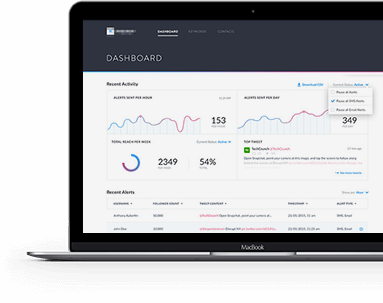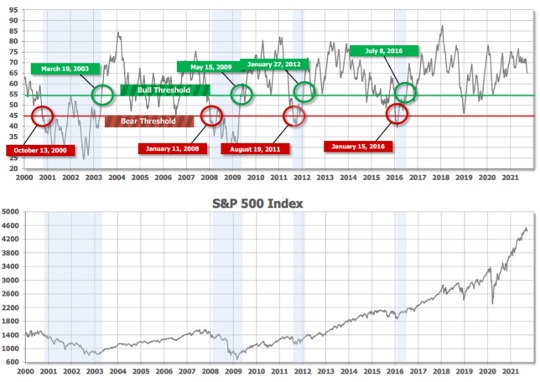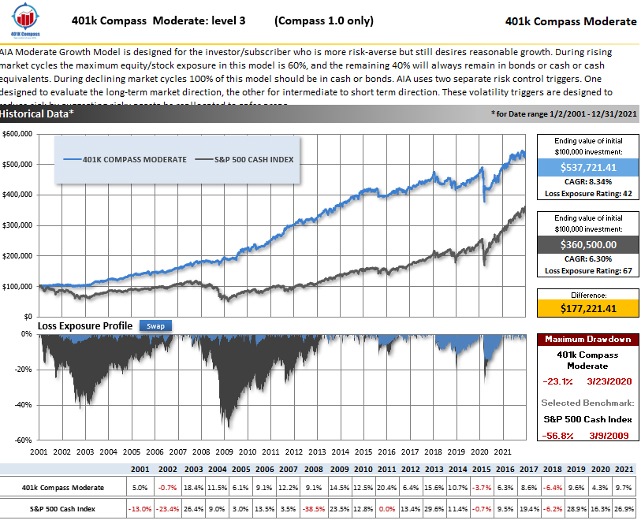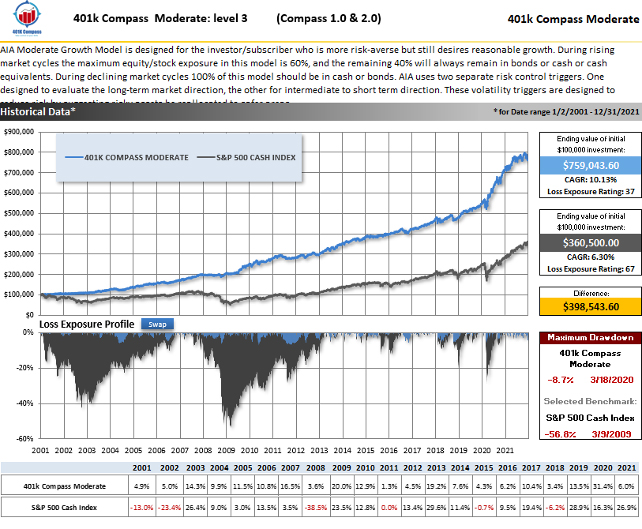401k Compass > Risk Management
take control
of your 401k!
We take the guesswork out of your 401k and reduce your risk all while delivering long-term success.

risk management
Risk Management is one of the primary features that set 401k Compass apart from the coward.
401k Compass uses a proprietary system to constantly analyze the stock market and economic conditions. This is done to provide subscribers with forward-looking allocation choices based on their specific 401k mutual fund choices. The technology is called Adaptive Investment Allocation (AIA).
AIA uses two separate risk management techniques or indicators.
Compass 1.0 focuses on the mid to long-term market direction.
Compass 2.0 focuses on the short-term direction of the market.
Both Risk Management indicators work in conjunction with each other. Compass 1.0 provides guidance on general or longer-term market direction and trends. Because all long-term positive trends will experience periods of short-term decline, the Compass 2.0 indicator is designed to help avoid most of the damage caused by these short-term setbacks.
See the Adaptive Investment Allocation (AIA) and Risk Management videos in our video library to learn more.
Both indicators must be positive for AIA to suggest allocation to maximum equity/stock market exposer as described in "Four Step Process".
If either indicator turns negative an Alert will be issued to all subscribers to reallocate their 401ks to minimum stock market exposure as described in the "AIA Process" video. see videos
risk management indicators: compass 1.0 and 2.0
Our primary tool for identifying longer-term market trends is the Compass 1.0 Indicator. Its job is to determine when a new Bull Market (increasing) or a new Bear Market (declining) has developed. Remember, we do not rely upon predictions, assumptions, estimates, or academic theories. The risk management indicators rely upon the data and metrics currently surrounding the market. In other words, we’re relying on facts, data, and math to make decisions.
The Compass 2.0 indicator acts as a short-term or early warning system of impending or continuing danger. It's the proverbial “canary in the coal mine”. When market data suggests near-term market distress, the Compass 2.0 indicator will issue an Alert, suggesting subscribers reallocate away from stock and equity mutual funds in favor of more conservative bond or cash funds.
These two indicators when used together can result in reduced risk and enhance long-term performance.
Remember the Compass 1.0 and Compass 2.0 risk management indicators must both be positive for AIA to suggest holding stock market positions in your 401k. If either turns negative, AIA will issue an Alert suggesting stock market positions be reallocated to bond or cash positions.
NOTE: Depending on your individual risk level, your asset allocation within your individual 401K may already be partially in bonds (See Step 2 of the Four-Step Process). AIA pertains to the portion of your 401K allocation that is stock mutual funds. For example, if your risk level is judged at level 3 by the Risk Assessment Questionnaire, your initial 401k allocation would be 60% stock funds and 40% bond funds. AIA would control the allocation of the 60% within stock funds. Because of your risk assessment, no more than 60% of your 401K with ever be dedicated to stock funds. AIA helps you consistently reallocate into the top-performing stock funds available to you within your specific 401K.
See the charts and graphs below and watch the Adaptive Investment Allocation (AIA) video in our video library for more details.
The first chart below shows the Compass 1.0 Indicator from the years 2000 to 2021. The red circles show the dates where our analysis indicated elevated market risk. Therefore, suggested stock market exposure was minimized (out of the market). The green circles show the dates where Compass 1.0 analysis judged the market risk as low, therefore increasing stock market exposure was suggested (in the market).
The simplest way to describe the value of using the Compass 2.0 Risk Management indicator in conjunction with the Compass 1.0 Risk Management indicator is to show you.
Below are 2 graphs. The top graph show AIA using only Compass 1.0 versus the S&P 500 Total Return Index. The bottom graph show AIA using both the Compass 1.0 and Compass 2.0 Risk Management indicators together.
Note: Both graphs use a more Moderate Risk Level of AIA allocation (60% AIA and 40% Bonds). Similar to the Level 3 described in Step 2 of “Four Step Process”.

As you can see in the bottom left graph using Compass 1.0 by itself reduces volatility and allows for increased long-term growth (see Loss Exposure Profile and Maximum Drawdown).
However, when applying Compass 2.0 with Compass 1.0 the results improve (bottom right graph). Compass 2.0 helps further reduce volatility and allows even more long-term growth.
See the Adaptive Investment Allocation (AIA) and Risk Management videos in our video library or request a demo for more details.
401k Compass is not a Registered Investment Advisor (RIA) and has no direct client accounts. Historical returns data has been compiled using price data provided by exchanges and not from actual accounts, and should therefore be considered to be hypothetical. Historical returns data is generated by applying the current models to the published historical timeframes using exchange-provided price data and may differ from historical returns data published using previous versions of the models.


ready to take control of your 401k?
